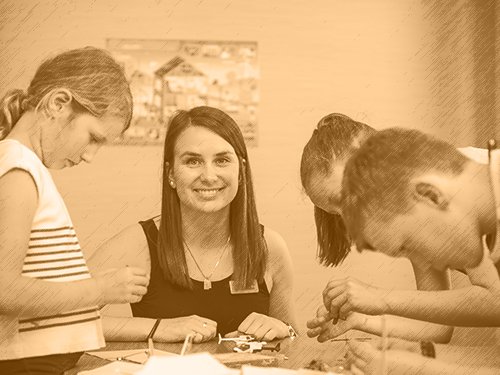This was a notable and sustained increase and helped to begin to normalise women’s presence in the profession. After opening the way with more complex and challenging conversations through the early 2000s, the 2010s saw significant progress and action. Existing groups and work programmes were now well established and there was support for new and bold initiatives. Diversity and inclusion received greater recognition and engineering firms, universities and IPENZ all showed commitment to these principles.
Women in construction
There was momentum in the 2010s to address even the most difficult areas and issues. A space that had long been considered a challenging one for women was construction sites. Women often reported feeling very conscious of their gender while on site and an accompanying pressure to prove their capability. Commonly reported issues included quips or inappropriate jokes, assumptions that they were in a junior role or not the engineer, a lack of safety gear in women’s sizes, and being told there were no toilet facilities for them. While some workplaces had always provided good support for their women staff going onto a construction site, some were unaware of how uncomfortable sites could be for women. An increasing focus on diversity and inclusion through the 2010s meant that any issues of discrimination or harassment were no longer just women’s issues but applied equally to everyone and were therefore easier to talk about. Companies had clearer policies in place and were willing to call out inappropriate behaviour.
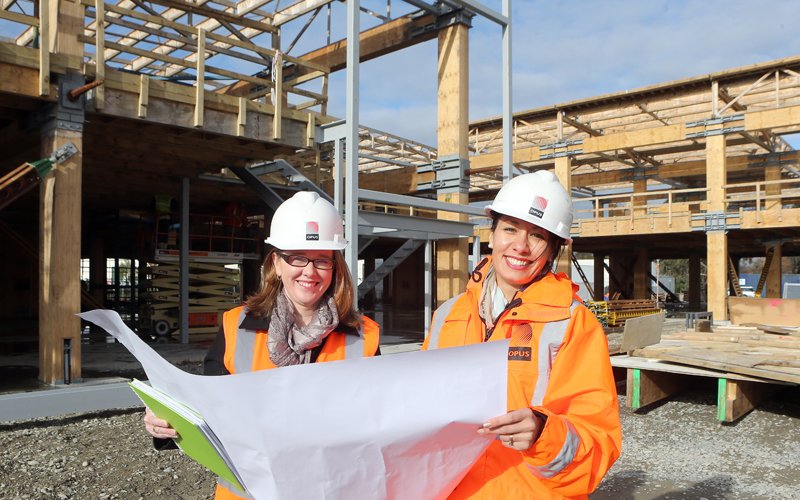
Structural engineer Diana Barr and civil engineer Sina Cotter Tait working on site as part of the Christchurch rebuild, 2013. Photo: © Stuff Limited
One organisation that had long been supporting women in this space is the National Association of Women in Construction (NAWIC). NAWIC is an international non-profit association founded in the United States in 1952. NAWIC New Zealand has been active in Wellington since 1996, and grew its presence in other regions through the 2010s. An Auckland chapter formed in 2012, and in 2024 there were chapters in seven other regions around the country. NAWIC supports, advocates for and celebrates women in construction. It runs in-person and online events – technical and professional development, site visits, speakers, networking, information sharing, and an annual awards evening – the NAWIC Excellence Awards. Women interviewed for this project shared their appreciation of the support and connections they have found as members of NAWIC.
Universities
In the first decade of the 2000s, the percentage of women enrolling in engineering at the University of Auckland hovered in the low 20s. This pattern continued until the second half of the 2010s when numbers at both Auckland and Canterbury began to show a sustained upward trend, reaching as high as 28 percent at University of Auckland in the early 2020s. Groups and programmes to support women engineering students were now well embedded at universities and received strong support from engineering faculties. Although still a minority, particularly in some disciplines such as mechatronics, women were an established presence in engineering schools and more comfortable to be themselves.
Support for women students and outreach to high schools
By the 2020s the University of Auckland’s Women in Engineering Network (WEN) had backing from both the university and industry and was an integral part of welcoming new female engineering students to the school. Students were automatically members of the group when they enrolled in engineering intermediate and ticked female or gender diverse on their enrolment form. The group runs many social, networking and professional development events throughout the year including meeting employers, speed interviewing, speed friending, as well as a mentoring programme that connects undergraduate students with industry partners. Mentors might be alumnae or from companies that have signed up as programme sponsors.
Students at University of Canterbury are also supported by their Women in Engineering (WiE) club. By the 2020s, the club had grown to approximately 800 members and offered students a full calendar of educational, industry and social events and a mentoring programme that matched students with industry professionals.
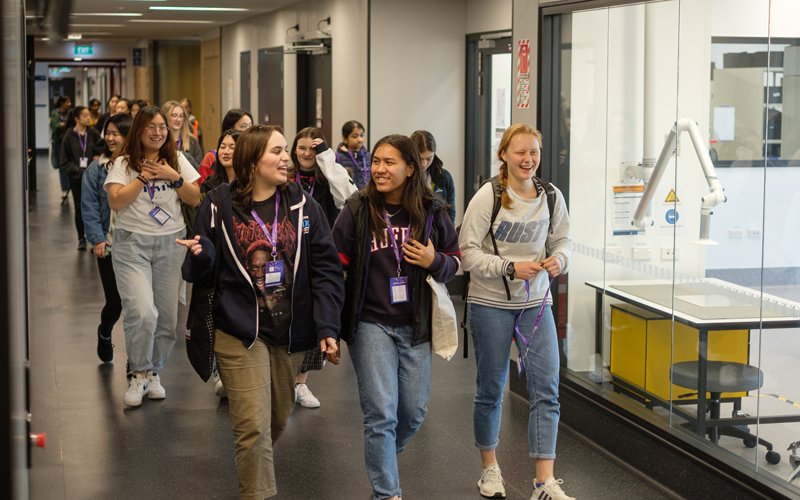
Students attend University of Auckland’s Enginuity Day, 2021. Photo: Richard Ng/University of Auckland
Both universities also continued to strengthen their outreach programmes to high schools. At University of Auckland, Enginuity Day continued to be a popular event for high school girls to explore the range of engineering disciplines offered at Auckland. And a schools outreach programme offered classroom visits with volunteers from WEN running hands-on workshops with students, giving them the opportunity to apply their knowledge of physics, maths and coding.
In 2019 the University of Canterbury launched WiE CAN (Women in Engineering at Canterbury), a 5-day/4-night residential programme for female high school students who have just completed Year 12. The programme involves interactive workshops and presentations where students complete hands-on projects and get a taste of the different engineering disciplines the university offers. After reading about similar schemes overseas, Professor Philippa Martin of Electrical Engineering took the idea to Professor Jan Evans-Freeman, who was then the College of Engineering Pro-Vice-Chancellor. Together they took the idea to the rest of the College team and developed the current programme. It was important to Jan that the programme was immersive and that students take at least one physical thing home with them that they had been involved in making. In 2024 the programme is still going strong and attracts five times as many applicants as the 60 places available. About 50 percent of the students attending the programme go on to enrol in engineering at University of Canterbury. The programme has had a noticeable impact on enrolment numbers at Canterbury, shifting the percentage of women enrolling in engineering from 17–19 percent in 2017–2018 to 20–25 percent through 2019–2023.
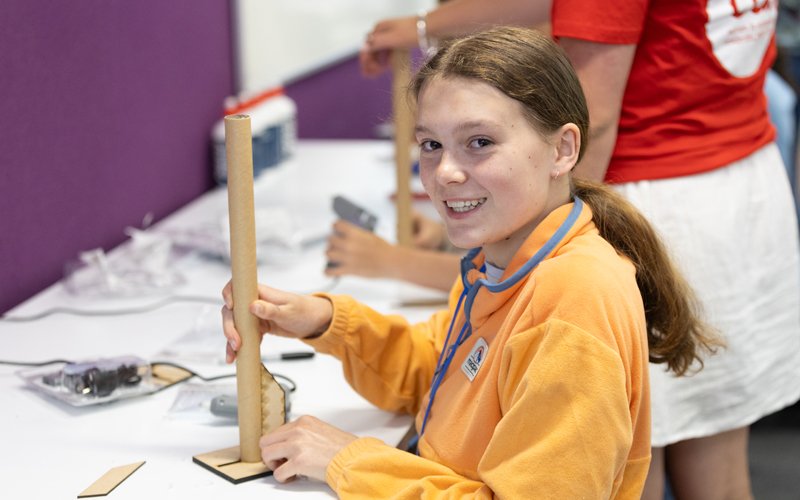
Students taking part in activities at WiE CAN camp, 2024. Photo: University of Canterbury
University academic staff
As well as outreach programmes and support for current students, universities had also been developing programmes to support their women staff. Through into the 1990s the expectation that women academic staff would take on pastoral care for the female students in their department was an extra burden on women already expected to take an active role in the ongoing campaign to attract women students to the engineering school and to champion gender equity. By the early 2000s both Auckland and Canterbury universities had women in leadership programmes and equity and diversity plans. Through the 2010s women were still underrepresented in senior academic positions (Associate Professor and Professor) across the university but this percentage was steadily increasing. At the University of Auckland, women in senior academic roles increased from 24 percent in 2010 to 34 percent in 2018.In engineering departments, numbers of women in academic roles have fluctuated over the decades and in 2024 women remained underrepresented. Women academic staff in engineering have been important role models for female students. Staff at University of Auckland observed anecdotally that where first year courses had been taught by women, female students were more likely to choose those disciplines for their specialisation.
At the University of Auckland, women were part of the Engineering School academic staff as early as 1973 when Dr Mary Farmer was employed as a part-time lecturer. Other early women academic staff in the school included Sue Truman who joined in 1975 as a junior lecturer after completing her PhD in Materials Engineering, and Susan Byrne, appointed in 1986 as a lecturer in the Department of Theoretical and Applied Mechanics. Margaret Hyland joined the University of Auckland in 1989 as a lecturer in Chemical and Materials Engineering. At the beginning of 2013 she was promoted to Professor – making her the first woman full professor in the engineering faculty. Between 2012–2017 Margaret also served as Deputy Dean of the faculty. In 2003 there were 12 women academic staff in the faculty and three research scientists. Rosalind Archer joined the University of Auckland in 2002. She was appointed Professor in September 2013 and served as Head of Department, Engineering Science, 2013–2020. She was the first woman to become a Head of Department in the Faculty of Engineering. She was then appointed Deputy Dean of Engineering, 2020–2021. In 2021 Rosalind also served as Engineering New Zealand’s third female president. Other women in senior positions in the Engineering Faculty at University of Auckland have included Suzanne Wilkinson, who joined the Department of Civil and Environmental Engineering in 1996 and was promoted to Professor in 2014; and Bryony James, who after completing her PhD at University of Auckland, joined the academic staff in 1997 and was Professor, Chemical and Materials and Deputy Dean (Research), 2016–2020.
At the University of Canterbury, the first women academics joined the engineering faculty in the 1980s. Early women academics in the engineering school included Anne Ditcher who joined as lecturer in Mechanical Engineering in 1981, and Kathryn Garden who completed her PhD in Electrical and Electronic Engineering at Canterbury and began as a lecturer in the department 1986. Susan Krumdieck was the mechanical engineering department’s first female full professor, appointed in 2014. Susan joined the University of Canterbury in 2000, and from 2000–2005 was the only woman academic on the engineering staff. In 2009, the university appointed Jan Evans-Freeman as Pro-Vice-Chancellor, Engineering. She was the first woman to fill this role. She served in this post until 2021 when she took up the role of Pro-Vice-Chancellor of Sustainability, at the University of Canterbury. During her time as Pro-Vice-Chancellor of Engineering, Jan worked proactively to support women academic staff, taking the time to ask about their aspirations and to offer opportunities that would give them the experience they needed as prerequisite for promotion. By 2023, women made up 23 percent of academic staff in the engineering department at the University of Canterbury, a significant increase on 2009.
IPENZ/Engineering New Zealand
Through the 2000s IPENZ had expressed concerns about the number of women leaving the engineering profession and the challenges women faced in attempting to balance work and family life. In 2010 the Institution took a more active role in trying to address these issues. IPENZ looked to position itself as a change leader and to collaborate with industry to better understand the challenges for women and to develop achievable actions to begin to address them.
In March 2011, IPENZ launched its Affirmative Action Programme with the aim to “support women to enter, remain and advance in the engineering profession.” The programme was guided by an oversight body made up of business leaders and IPENZ Board Members. The first actions under the programme were to undertake research to better understand the current situation, women’s experiences in the profession and the barriers they faced; to establish a business case for diversity; and to complete an audit of the Institution’s own policies and practices.
The results of a survey and interviews undertaken as a joint research project in collaboration with the Ministry for Women’s Affairs revealed that almost 30 percent of female respondents, compared with 18 percent of men, had left the profession within five to ten years of graduating. Reasons for women leaving included not enjoying engineering or the workplace culture, or moving into different areas such as corporate finance, business analysis, or research. A survey of IPENZ’s own members showed that women were far more likely than men to have experienced sexual harassment and gender discrimination at work – 18.8 percent of women compared with 1.4 percent of men and 34.5 percent of women and 3 percent of men, respectively.
Another challenge for women discussed in the joint IPENZ/Ministry for Women’s Affairs research project was the difficulty of balancing work and family life. Despite many companies having flexible working policies, there was low uptake of these. This was attributed to company culture where part-time work meant being assigned less interesting or less challenging roles and limited career progression. The challenges women faced in progressing their careers was evident in the uneven spread of men and women across salary bands. While there were roughly equal proportions of men and women in the mid-range salary band, there were twice as many men than women in high salary bands and three times as many women than men clustered in low salary bands.
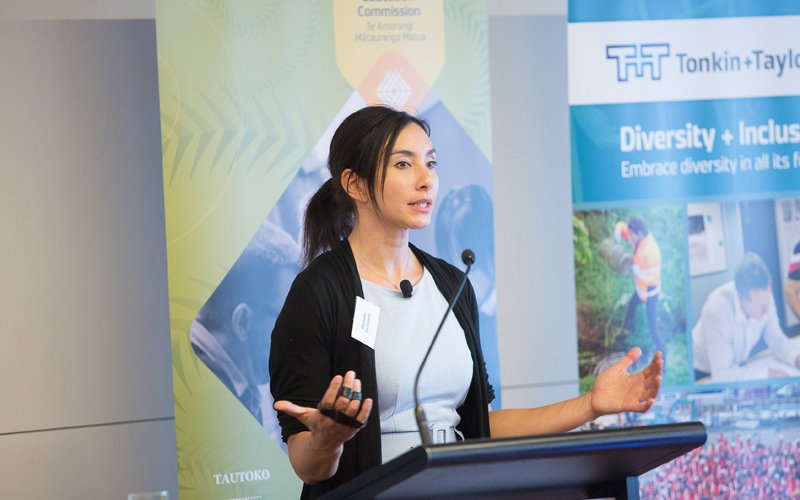
Michelle Dickinson AKA Nanogirl, guest speaker at the IPENZ Diversity in Action summit, August 2016. Photo: Engineering New Zealand
To track and report on the success of the programme, IPENZ published annual snapshot reports. The data for these was gathered through a survey of participating engineering organisations. Other challenges for women identified through this research included a lack of visible role models and a lack of networks or difficulty in maintaining professional networks, resulting in a feeling of isolation.
Ongoing initiatives established as part of the Affirmative Action Programme included networking events for female engineers; a bi-monthly newsletter, Engineering Diversity, for engineering leaders; and twice-yearly events with engineering chief executives “to share best practice and promote improvement of the profession’s culture.” IPENZ also made a commitment to profile more female engineers in its publications. Progress towards the programme’s aims were tracked through changes in education data, IPENZ membership data and census data.
From an initial focus on women, the programme was extended to encompass diversity and inclusion more broadly. The programme grew to include other underrepresented groups, or groups that needed specific support including Māori and Pasifika engineers, immigrant engineers and engineering technicians and technologists. In developing the programme, IPENZ worked with other professional organisations including the New Zealand Institute of Architects, who were also looking at ways to increase diversity and support inclusive practices within their profession. The programme was also successful in gaining the support of engineering firms. This collaborative approach laid the foundations for the development of the Diversity Agenda, which launched in 2018.
In 2010, 12 percent of IPENZ members were women, this was roughly in line with the percentage of women engineers in New Zealand overall. But the majority of IPENZ’s female members were clustered in the student and graduate member classes. Only 6 percent of women were Chartered members and only 2 percent were Fellows. Women were also underrepresented across IPENZ boards. In 2016, IPENZ launched a new strategy with the vision “to engineer better lives for New Zealanders,” and mission “to bring engineering to life.” The following year the Institution rebranded to become Engineering New Zealand. These changes were focused on “re-engineering IPENZ as a relevant and modern organisation,” to be member focused and welcoming to engineers of all disciplines and careers stages. Engineering New Zealand’s Technical and Special Interest Group committees and Governing Board have become more welcoming and representative. After a gap of almost 20 years since Gretchen Kivell served as IPENZ President in 1998, Elena Trout was elected president in 2016; Rosalind Archer followed in 2021 and Jan Evans Freeman in 2024. An effort has also been made to make the pathway to Fellowship and Distinguished Fellowship easier to navigate and to encourage applicants from a diverse range of disciplines, regions, ethnic and cultural backgrounds and genders to apply. Gretchen Kivell became IPENZ’s first woman Fellow in 1993. By 1998 there were three women Fellows. By 2010, numbers had reached double digits and from then on increased rapidly. In 2024 Engineering New Zealand’s membership included 50 women Fellows and six Distinguished Fellows. Gretchen Kivell was the Institution’s first woman Distinguished Fellow in 2005.
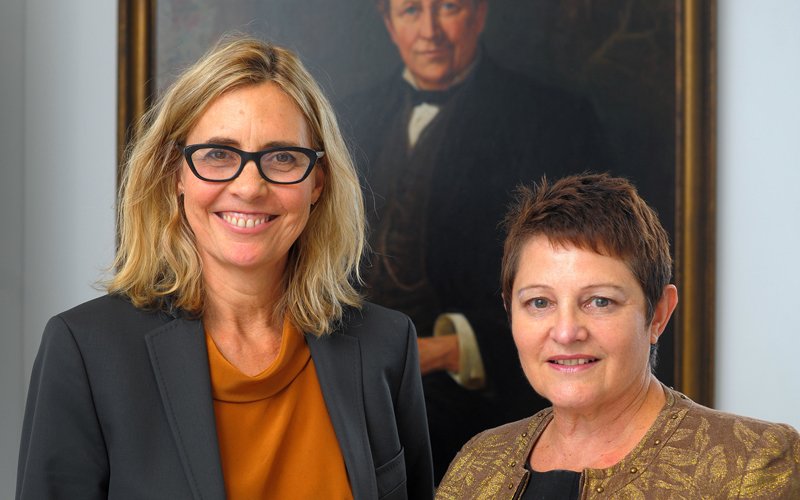
IPENZ Chief Executive Susan Freeman-Greene and President Elena Trout, May 2016. Photo: Dave Lintott/Engineering New Zealand
Wonder Project
Following a review of Engineering New Zealand’s schools programme, Futureintech, the programme was revamped and relaunched as the Wonder Project in 2018. Like Futureintech, the Wonder Project aims to increase students’ participation and interest in STEM and runs with the support of STEM professionals who volunteer their time to join classrooms and act as Ambassadors. Wonder Project challenges are designed to appeal to girls and boys equally and to show students the relevance of engineering to their lives. The programme was largely funded by Callaghan Innovation through the Ministry of Business, Innovation and Employment (MBIE) until May 2023 when they decided to no longer invest in STEM promotion. Despite this setback, Engineering New Zealand considered the programme too important not to continue and in 2024/2025 will move to a 100 percent industry-funded model, while seeking support from Government to reinstate a portion of funding.

Students at St Mary's Catholic School in Auckland participate in the Wonder Project Rocket Challenge, 2023. Photo: Tim Hamilton/Engineering New Zealand
The Wonder Project is designed for Year 5–13 students and unlike Futureintech, has specific hands-on curriculum-aligned challenges for different year level groups. Students are provided with materials and guided by their teacher and Wonder Project Ambassador through the project. In 2024 the projects were the Rocket Challenge, where students build and launch a water rocket; the Power Challenge where students design and build a wind turbine to light up a mini town; and the Water Challenge where students construct and test a mini model of Aotearoa New Zealand’s water network. For senior students, there is an option to visit workplaces and hear presentations by professionals about their work.
From its launch in 2018 through to 2024, the programme has been in 1,300 unique schools and with the support of over 2,000 Ambassadors has engaged nearly 140,000 students. Results of post-project surveys show 88 percent of students had their perceptions of STEM shifted positively and 50 percent of students were now more interested in a STEM career. 96 percent of teachers reported increased confidence in teaching STEM.
Diversity Agenda
The Diversity Agenda launched in April 2018. It is a joint initiative from Engineering New Zealand, the New Zealand Institute of Architects and ACE New Zealand. Its initial goal was to see 20 percent more women engineers and architects by 2021. The campaign has since expanded beyond gender to include Māori, Pacific Peoples, LGBTQIA+, disabled, neurodiverse and other minority groups.
The vision of the Diversity Agenda is for the engineering and architecture industries to be “inclusive, respectful and representative of society – where everyone feels safe and valued in their workplaces, and young people want to be engineers and architects.”
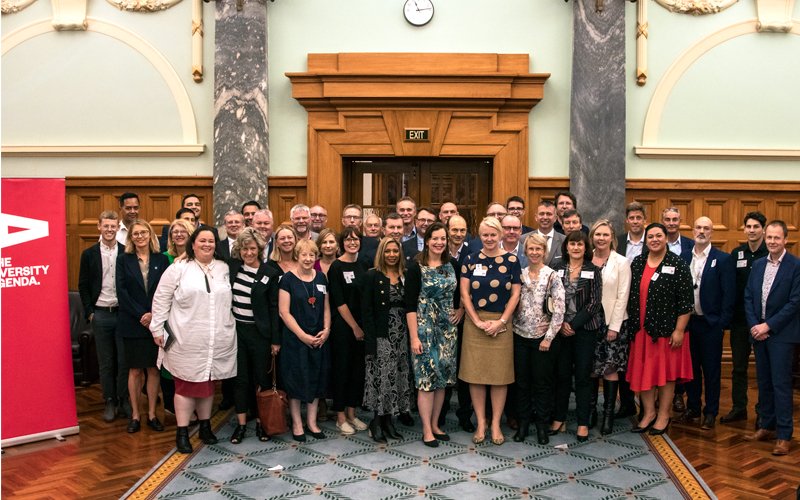
Signatories at the launch of the Diversity Agenda Accord, Parliament, Wellington, 2 February 2020. Photo: Engineering New Zealand
Engineering and architecture firms join the Diversity Agenda as members and receive access to resources, events, tools and tips to help them on their diversity journey. To show their commitment, business leaders then sign the Diversity Agenda Accord – committing their company to following a set of principles to promote diversity and inclusion in their workplace and to report on their progress. Reporting measures include the percentage of women in their company, percentage of women in senior leaderships roles, and the gender pay gap. The Diversity Agenda launched with 47 founding members, and in 2024, had 53 Accord signatories. The programme is fully funded by membership fees.
“While there is still much work to do,” the Diversity Agenda already has some wins to celebrate. Accord firms have made progress in women’s representation in senior leadership roles and have closed the gender pay equity gap to 0.3 percent. 90 percent of Accord signatories also have a Māori strategy and workplan to increase their company’s cultural competence in Te Ao Māori.
Conclusion
Between 2010 and 2024, conversations about women in engineering opened to include workplace culture and women’s experience in the workplace. A growing understanding of the benefits of diversity and inclusion – not just for women, but for everyone – has made these conversations easier and empowered more people to take an active role in creating a culture where everyone can thrive.
Acknowledgements
A massive thank you to all the women who shared their stories as part of this project and all those who provided information and recollections which helped to inform the written history.
Interviewees
Alice Xu, Charlotte Toma, Emily Collings, Gretchen Kivell, Jan Evans-Freeman, Janis Swan, Jess Court-Patience, Kate Macdonald, Kaye Clark, Kim Rutter, Lily Sanson, Philippa Martin, Rebecca Ronald, Rosita Fiaola, Sharee McNab, Shelley Wharton, Sheridan Fathers, Sina Cotter Tait, Te Rina Kotara, Zoe Millar.
Those who helped with information and shared their memories
Liz Godfrey, Catherine Watson, Mike O’Sullivan, Lou Wickham, Tracey Ayre, Margaret Hyland, Rosalind Archer, Suzanne Wilkinson, Bryony James; staff at WEN Women in Engineering Network, University of Auckland: Ashleigh Fox, Caitlin Scragg and Kelly Moodie; staff at University of Canterbury who assisted with information and statistics: Saurabh Sinha, Aisling O’Sullivan, Alex James, Melissa Barber; Holly Rausch and Charlotte Downes at the Diversity Agenda.
Also thanks to
Sarah Walker and Ashleigh McLarin at the Alexander Turnbull Library; the team at Te Ao Rangahau.
The author
Enormous thanks to the dedicated author and catalyst behind this project – Heritage Advisor at Te Ao Ranagahau, Cindy Jemmett.

